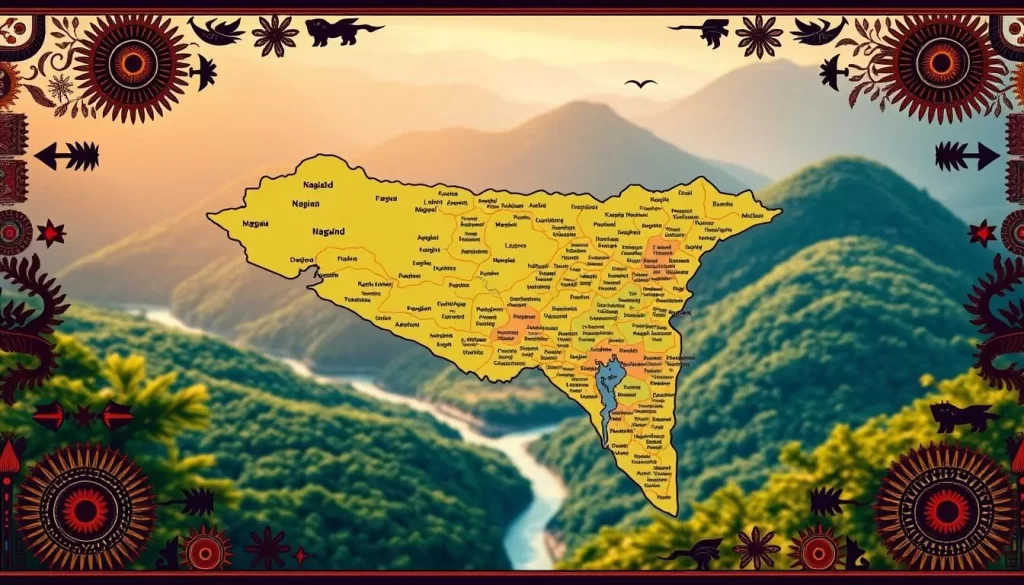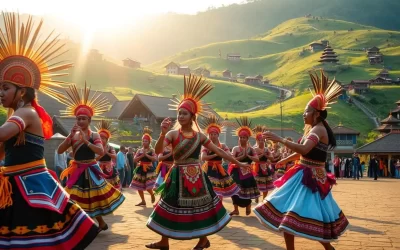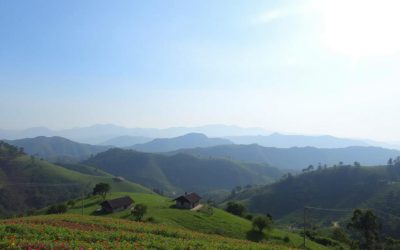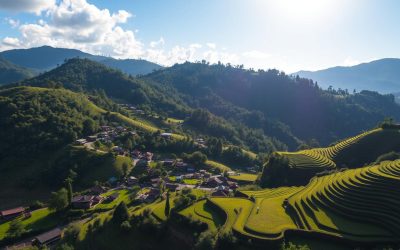✓ Accommodations✓ Flights✓ Rental Cars
You’re about to explore the fascinating linguistic landscape of Nagaland, a region known for its incredible cultural diversity. Located in the northeastern part of India, this mountainous state is home to a multitude of languages.
As you delve into the world of Nagaland’s languages, you’ll discover the rich tapestry of dialects and the historical context that has shaped the linguistic identity of its people. Understanding the language situation in Nagaland will provide you with valuable insights into the cultural complexity of this intriguing state.
The diverse languages spoken across Nagaland reflect the state’s tribal heritage, colonial history, and modern development, making it a unique and captivating region to explore.
The Linguistic Landscape of Nagaland
Nagaland is a linguistic mosaic, with a multitude of languages and dialects spoken across its various tribes and subtribes. This diversity is a reflection of the state’s rich cultural heritage.
Geographic and Cultural Context
Nagaland, with its diverse tribes, presents a unique linguistic profile. The state’s geography, with its hills and valleys, has contributed to the development of distinct languages and dialects among its population.
Language Diversity in Numbers
The population of just under 2 million speaks an estimated 60 different dialects belonging to the Sino-Tibetan language family. Some key statistics highlighting this diversity include:
- Nagaland is home to 16 major tribes, each with its own distinct language.
- The tribe has several subtribes with their own linguistic variations.
- Even neighboring villages within the same tribe may speak noticeably different dialects.

English: The Official Language of Nagaland
The official language of Nagaland is English, which has gained widespread acceptance among its people. As the state‘s official language, English plays a crucial role in various aspects of life in Nagaland.
Historical Introduction of English
English was introduced to Nagaland during the British colonial era. It has since become an essential part of the education system, serving as the primary medium of instruction.
Current Usage and Importance
Today, English is widely spoken among the educated population and speakers of different tribal communities. You can see its importance in government, education, and official communication. Some key aspects of English in Nagaland include:
- Serving as a bridge between different tribal communities.
- Being highly valued for education and employment opportunities.
- Being one of the primary language spoken by the younger generation.

Nagamese: The Lingua Franca
As you explore the linguistic landscape of Nagaland, you’ll discover Nagamese playing a crucial role as a lingua franca. Nagamese has emerged as a vital language for communication among the diverse population of Nagaland.
Origins and Development
Nagamese has gained popularity due to its simplicity. It lacks a standardized written form and grammatical complications, making it easy to learn and use. This simplicity is a key factor in its widespread adoption.
Characteristics and Widespread Use
Nagamese is characterized by its simplified grammar and lack of gender classifications, making it a straightforward language to communicate in. You’ll find that it’s widely used in markets, inter-tribal gatherings, and casual communication. Some key features include:
- Simplified grammar and syntax
- No gender classifications
- Primary language for inter-tribal communication
Nagamese serves as a bridge between different languages and dialects, facilitating communication among people from various tribes. Its widespread use across different age groups and communities solidifies its position as the true lingua franca of Nagaland.
Nagaland, India: Official and Widely Spoken Languages by Tribal Groups
The Naga tribes exhibit a remarkable linguistic diversity, with around 60 dialects belonging to the Sino-Tibetan language family. In some areas, dialects vary even from village to village, making language a significant aspect of tribal identity.
Major Tribal Languages
Nagaland is home to several major tribal languages, each associated with a specific tribe or region. The Aos and Angamis are two prominent tribes with distinct languages. You can observe that the linguistic distribution in Nagaland follows tribal and geographical boundaries.
Linguistic Distribution Among Tribes
The distribution of languages in Nagaland reflects historical migration patterns and settlement of different Naga tribes. You can see that the Aos are primarily found in Mokokchung district, while the Angamis are concentrated around Kohima district. The table below illustrates the linguistic distribution among some major tribes:
| Tribe | District | Language/Dialect |
|---|---|---|
| Aos | Mokokchung | Ao |
| Angamis | Kohima | Angami |
| Other Tribes | Various | Various Dialects |

Classification of Naga Languages
You can gain a deeper understanding of Nagaland’s languages by exploring their classification. The Naga languages are part of the Sino-Tibetan language family, which is one of the largest language families in the world.

The Naga languages are further divided into three sub-groups: Eastern, Central, and Western. Each sub-group has its unique characteristics and is spoken in different parts of Nagaland.
Eastern Sub-Group Languages
The Eastern sub-group includes languages such as Chang, Khiamniungan, and Phom. These languages are spoken in the eastern parts of Nagaland and have distinct grammatical features.
Central Sub-Group Languages
The Central sub-group comprises languages like Lotha, Zeme, and Rongmei. These languages are spoken in the central regions of Nagaland and share some similarities with the Eastern sub-group.
Western Sub-Group Languages
The Western sub-group includes languages such as Angami, Sema (Sumi), Rengma, and Chakhesang. These languages are spoken in the southwestern parts of Nagaland and have been influenced by neighboring languages, including those from Manipur state. Angami, spoken around Kohima, has several dialects, including Tenyidie, which has become standardized for written purposes.
- The Western sub-group languages have distinctive features that set them apart from the other sub-groups.
- Understanding the classification of Naga languages helps appreciate the linguistic diversity within Nagaland.
Written Scripts and Literature in Naga Languages
As you explore the linguistic landscape of Nagaland, you’ll discover the significant role of written scripts and literature in Naga languages. The introduction of a written script has been instrumental in preserving and promoting these languages.
Roman Script Introduction
The Roman script was introduced to Naga languages, providing a written form to previously oral traditions. This script has become the standard for writing in many Naga languages, facilitating the creation of literary works and educational materials. The use of the Roman script has been pivotal in giving Naga languages a written identity, enabling their use in formal education and literature.
Books, Dictionaries, and Media
The development of literature in Naga languages has been remarkable, with numerous books, dictionaries, and media products emerging. Many tribes have their Holy Bible and hymn books written in their languages using the Roman script. For instance, the Chang-English Dictionary, compiled by Achilla Imlong Erdican, has gained international recognition and is available in leading universities worldwide, including Cambridge, Yale, and Harvard. You can see the impact of this literary development in the table below, highlighting some key publications in Naga languages.
| Language | Publication | Year |
|---|---|---|
| Jungli Ao | Temeshi Lai (Holy Bible) | – |
| Chang Naga | Grammar of the Chang Naga tribe | 1922 |
| Chang Naga | Changebu Lei: First Chang Naga Reader | 1928 |
| Chang Naga | Chang-English Dictionary | 2003 |
Language Preservation Efforts in Nagaland
In Nagaland, a concerted effort is being made to preserve the rich linguistic heritage of the state. Various stakeholders, including the government, media, and local communities, are working together to promote the use of tribal languages.
Role of Media and Education
The media plays a vital role in language preservation, with All India Radio stations in Kohima and Mokokchung broadcasting programs in local languages. Printed newspapers and newsletters, such as the Ao Milen and Phinjen, also contribute to language preservation. Educational institutions are also promoting tribal languages through curriculum development and cultural events.
Community Initiatives and Government Support
Community-led language documentation projects are underway to record and preserve endangered dialects. Tribal organizations are organizing cultural events and workshops to promote tribal languages among younger generations. The Nagaland government has implemented policies to support tribal language education and development. You can see the impact of these efforts in the table below:
| Language | Tribe | Media Presence |
|---|---|---|
| Ao | Ao tribe | Ao Milen (newspaper) |
| Chang | Chang tribe | Phinjen (monthly newspaper) |
| Angami | Angami tribe | Newsletters and local broadcasts |
Conclusion: The Future of Nagaland’s Linguistic Heritage
As we conclude our exploration of Nagaland’s linguistic landscape, it’s clear that the future of its languages is closely tied to the vitality of village life. You’ve learned that while urbanization and education in dominant languages like English pose challenges, they also provide Naga people with tools to document and promote their own languages. The balance between embracing modernity and preserving linguistic traditions will determine the future trajectory of Nagaland’s languages. This situation is not unique to Nagaland; neighboring states like Arunachal Pradesh face similar challenges. The resilience of Naga tribes and their commitment to their cultural heritage will be crucial.
The above is subject to change.
Check back often to TRAVEL.COM for the latest travel tips and deals.




